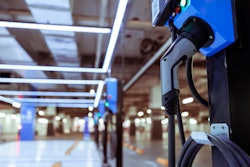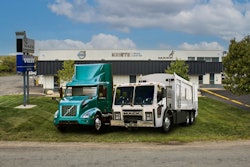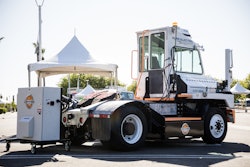Portland, Oregon-based Titan Freight Systems falls way below the asset-count cutoff for a mega fleet, but the three-state motor carrier is hanging in there with the big boys and girls when it comes to including battery electric trucks into its fleet.
Joining Jason and Matt on the 10-44 this week is Titan Freight CEO Keith Wilson, and his company is proof that if you know how to navigate the network of available subsidies and partnerships (or are at least willing to learn), the up-front costs and the process don’t have to be so painful.
Contents of this video
00:00 10-44 intro
00:25 Small fleet with battery electric trucks
01:12 Grants, subsidies, and partnerships
03:47 Truck range and equipment operating costs
05:37 Unexpected challenges for electrifying a fleet
08:39 The process of electrifying a fleet
10:23 Understanding the resources and partnerships
Jason Cannon (00:00):
This week's 10-44 is brought to you by Chevron Delo 600 ADF, ultra-low-ash diesel engine oil. It's time to kick some ash. We've got proof that you don't have to be a mega fleet to go all electric.
(00:14):
You're watching CCJs 10-44, a weekly webisode that brings you the latest trucking industry news and updates from the editors of CCJ. Don't forget to subscribe and hit the bell for notifications, so you'll never miss an installment of 10-44.
(00:28):
Hey everybody, welcome back. I'm Jason Cannon, and my co-host is always on the other side is Matt Cole. With 45 trucks and 125 trailers, Titan Freight Systems falls way below the cutoff for a mega fleet, but the Portland, Oregon-based motor carrier is hanging in there with the big boys and girls when it comes to including battery electric trucks in its fleet.
Matt Cole (00:47):
The prevailing theory is that a leading-edge conversion to electric is best left to large companies with an R&D budget. Since upfront costs are so high and the opportunity to make a misstep seems pretty likely.
Jason Cannon (00:58):
Joining us on the 10-44 this week is Titan Freight CEO Keith Wilson and his company's proof that if you know how to navigate the network of available subsidies and the partnerships, or you're at least willing to learn how to do that, the upfront costs don't have to be so painful.
Keith Wilson (01:13):
We had an opportunity through grants, through the VW mitigation grant through Oregon, to cover 75% of the overall CapEx cost for the equipment and also the infrastructure. Well, knowing that we are really focused on a fossil fuel-free future, we jumped at that opportunity because we like being first in, and we know we jumped into the deep end without any knowledge, but we knew that with the 75% grant, it was going to have an immediate financial windfall for us because we did the total cost of ownership on the project and the total cost of ownership with the CapEx for the equipment being at 400K instead of 130K for a diesel counterpart. With the infrastructure being covered and then looking at the overall cost per kilowatt, we were amazed at the profit that this new equipment was going to add to our business. So we went all in on it.
(02:02):
I mean, it was an easy move for us when we looked at the overall bottom line improvement for the company, and more importantly, it was a perfect focus on our sustainability core value. So it really said, "Go, move." We've been really heartened since then. Portland has become the first city to focus on a zero-emission zone in our downtown core. So now, not only are we going to be the only carrier with electric trucks, we're going to be able to have an economic opportunity where we're delivering to a captive area of Portland now, a area that's only going to allow us electric vehicles to make deliveries to certain addresses. The really important thing is, we're in what's called the Portland General Electric area, right? We have two competitors, Pacific Power and Portland General Electric. Our facility here at our Portland facility is a PGE. We're a PGE customer.
(02:53):
They said if we signed a contract to commit a certain amount of kilowatts to them, that they would bring the line from the street to the dispenser for free. That was a $500,000 reduction in cost that they provided. We have a 10-year contract, but looking at our overall KW spend, what we were going to have to do in kilowatts, it was a very realistic contract, so we jumped in on that. The infrastructure for our six dispensers was about a million dollars, and they put in all the infrastructure or bringing the line to us, which was about 500K with no charge. So we've gotten an awful lot of support. Not only that, but now that 19 cents per kilowatt hour that we pay to PGE, our Oregon Clean Fuels program's going to credit us for a vast majority of that. So we're essentially charging our trucks for free, and that's because of our Oregon Clean Fuels program.
Matt Cole (03:47):
Titan has just more than a month under its belt with three electric trucks, and three more are on the way. But Keith said so far they have shown a 9% lower equipment operating costs per mile over their diesel counterparts, and range so far has been a non-issue.
Keith Wilson (04:01):
We are getting the exact cell that Freightliner had given to us, so they said that the truck range was 150 miles. When we fully charge, it'll come to us, and the driver will get in the vehicle, and it'll be over 200 miles. It'll say over 200 miles, but their range promise to us was 150 mile range. Our routes in our Portland market are 100 miles, and so we are bringing the trucks back with 34, 50, 60 extra miles on the charge. What we found, which was really outperforming because they're in primarily a delivery routine, we are getting a 26% regen power back to the vehicle. In other words, we're producing our own power because they're in that stop-and-start environment. We are getting through renewable energy. The regeneration, a 26% power increase from that technology. We have one tractor doing doubles and triples every day to a local customer, and that will compromise or that will use the electricity at a higher rate as well.
(05:00):
We've had no issues with a truck dying on the side of a road because it ran out of energy. And keep in mind, there's only two charging stations in all of Portland right now, and we have one of them, and the other one is at the Freightliner factory. But there are DC fast chargers coming online that have a 350 kilowatt capability, and there's a whole host of them coming online in the Portland market. So even if say, we were running low, we just run a driver over to a dispensing station, just like a gas station, if you will, and we'll put some KW's in it to get them back to our facility.
Jason Cannon (05:35):
We've been here for years. How complex and off-putting the acquisition and buildout for electric fleets is going to be, but it sounds like Keith's killing it, and he is right now, but he said it's definitely not been an easy process. What were those unexpected challenges and hiccups, and how did he overcome them? Well, Keith tells us after a word from 10-44 sponsor Chevron Lubricants.
(05:55):
Protecting your diesel engine and its aftertreatment system has traditionally been a double-edged sword. The same engine oil that is so essential to protecting your engine's internal parts is also responsible for 90% of the ash that is clogging up your DPF and upping your fuel and maintenance costs. Outdated industry thinking still sees a trade-off between engine and emission system protection, and Chevron was tired of it, so they spent a decade of R&D developing a no-compromise formulation.
(06:20):
Chevron lubricants developed a new ultra-low-ash diesel engine oil that is specifically designed to combat DPF ash clogging. Delo 600 ADF with OMNIMAX technology cuts sulfate ash by a whopping 60%, which reduces the rate of DPF clogging and extends DPF service life by two and a half times. And just think what you can do with all the MPGs you're going to add from cutting your number of regens. But Delo 600 ADF isn't just about aftertreatment. It provides complete protection, extending drain intervals by preventing oil breakdown. Before, you had to choose between protecting your engine or your after-treatment system, and now you don't. 600 ADF from Delo with OMNIMAX technology, it's time to kick some ash.
Keith Wilson (07:02):
Here's one of the biggest issues is permitting code, right? I always say this, that when you buy an electric truck, it's like you got to buy a gas station at the same time, so it's a completely different dispensing or fuel environment, and the cities aren't set now for charging infrastructure. They think it's a gas station, or they think that they have to have this permitting. Who's behind right now is the codes in the jurisdictions because it's so new. The people who are adding infrastructure, like, "Keith, you won't believe what I'm going to have to do or the permitting costs I'm going to have to do." Yet the jurisdictions are all focused on decarbonizing. They've actually created roadblocks because their codes aren't up-to-date and aren't ready, and they're applying a Byzantine-type code to a very new emerging market, and that disconnect is slowing the whole process down.
(07:51):
Yet in Oregon, we have this tremendous desire to electrify everything. In fact, we passed the advanced clean transportation rule just like California. Interesting. So we pass all these jurisdictional accelerants to move to electric, but when it comes to it and the codes, they're focused more on the last century than they are this century. So I'm trying to help carriers through that and connecting them with policymakers to, "Hey, you got to go look at this." So it's really slow for others. We had a four-year ramp on this where we were working with Freightliner, working with PG, so being the first, we really had everybody helping us row the boat, if you will, through the whole process. But I'm now starting to hear other people who are electrifying their fleet locally that are running up to code challenges.
Matt Cole (08:36):
A lot of the industry is trying to get where Keith is right now, and others will eventually be dragged there as unwilling participants. Keith's best advice for both groups, take your time because this isn't going to be a fast process.
Keith Wilson (08:49):
Really, the important part is to just get an understanding of how to decarbonize and electrify your fleet. So if you haven't electrified your shop, do it, and do it quickly. Learn how those little, small steps can really improve your operations and your profitability. Then move on to your warehouse. Electrify your warehouse equipment. We don't have any propane forklifts. We electrified them all. It gave us a great opportunity to learn charging three phase how to maintain a piece of equipment. So our mechanics now are comfortable with that electric already. We then moved to L 2 chargers for all of our sales and our management fleet, so we added a L 2 charger, right? So we added 220 volts with 200 amp facilities, so that helped us learn more, and then we took the big bite and we went for DC fast charges and electrification of our heavy-duty electric vehicles.
(09:40):
So we took a stepped margin, a step, and intentional process to get to this point. Give yourself a ramp. It's definitely start on infrastructure today because it's an 18-month process from the time you begin planning to the time you get your first charge. It's an 18-month process. I'm going to buy a diesel vehicle today and have the charging infrastructure or the fueling infrastructure already there. It really is a two-part process, and infrastructure has to be done earlier, or at least at the same time you're purchasing your actual vehicle.
Jason Cannon (10:20):
Keith says it's also key to understand all of the resources and partnerships that are available to you.
Keith Wilson (10:26):
Get your Clean Cities group onboard quickly. That's a Department of Energy group that helps companies electrify their region, and it's called Clean Cities, and most regions in the US have that. They know what grants are available, find the grants, and utilize because there's a lot of money out there. Michael Graham in our area went to work, and he found so many grants for us that there's money there to be paid. And then, with the new IRA legislation, there's a grants for this. The federal government has the 40,000 medium-duty grant that's available today.
Jason Cannon (11:00):
That's it for this week's 10-44. You can read more on ccjdigital.com. While you're there, sign up for our newsletter and stay up to date on the latest in trucking industry news and trends. If you have any questions or feedback, please let us know in the comments below. Don't forget to subscribe and hit the bell for notifications so you can catch us again next week.









